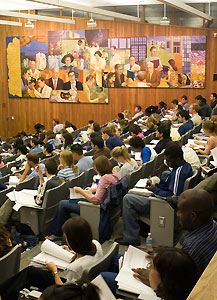  |
| HOME | THIS ISSUE | CALENDAR | GRANTS | BACK ISSUES | < BACK | NEXT > |
Medical, dental school students reflect state’s diverse populationby Pat Keefe - September 26, 2005 |
||||
|
Efforts by the School of Medicine and the School of Dental Medicine to diversify the student body seem to be paying off. Some 23 percent of the students in the medical school’s Class of 2009 are traditionally underrepresented minorities, as are 26 percent of the dental school class. In the 79-member medical class, 15 students are African American, one is Hispanic, and two are Puerto Rican. In the 38-member dental class, five students are African American and five are Hispanic. “We’re pleased with the demographics of the Class of 2009,” says Dr. Lamont MacNeil, vice dean for dental academic affairs. “The students display superior academics, broad ethnic and cultural diversity, and extracurricular achievement. “The Health Center’s intention is that the student body reflect the population of the state of Connecticut, including its diversity,” he says. “We’re pleased that the entering class really mirrors the diversity of the population at large.” Dr. Bruce Koeppen, dean of academic affairs and education, says, “The credentials of the class and its diversity are a testament to the hard work of the members of the admissions and the Health Careers Opportunity Programs. As a group, the students are intelligent, highly motivated, and are coming to medicine with a strong commitment to serve others.” The Class of 2009 is notable also because UConn’s Combined Programs in Medicine and Dentistry have their first students at the Health Center. The program, begun in 2001, offers combined BA/BS and MD/DMD degrees and guaranteed admission to the University’s medical or dental school for UConn students who meet the requirements of matriculation into the professional program. Two students from the program joined the medical school; one joined the dental school. “I am pleased that the first cohort of students from the combined program have matriculated,” Koeppen says. “This marks an important milestone for the program, and these students will help strengthen the connection between the School of Medicine, the School of Dental Medicine, and those students in the program at Storrs.” Women continue to show an overwhelming interest in medicine: 71 percent of the medical class are females, while in the dental school, women represent 37 percent.
Dr. Anthony Ardolino, associate dean for student affairs, says this year’s class continues a trend begun in the medical school a couple of years ago. “That’s the largest percentage of women we’ve ever had,” he says. “In the mid-1980s, we were pretty much 50-50, but that’s changing.” Some 55 percent of the applicants this year were women, Ardolino says. In addition, the second-year class has 63 percent women and the third-year class has 67 percent women. “I think women realize there are opportunities in medicine that may not exist in other fields,” he says. Both schools are fulfilling their original charge to educate the sons and daughters of Connecticut and New England. In the medical school, 60 percent of the new class are from Connecticut, and a total of 85 percent of the students are from New England. Some 44 percent of the dental class are from New England. Both schools offer education that thousands would love to have: 2,700 applied for 80 medical school positions; 1,122 applied for 40 positions in the dental school. “The Class of 2009 represents all that we expect from our incoming dental students,” says Dr. Edward Thibodeau, assistant dean for admission. “They have superior academic qualifications, an in-depth understanding of the profession, and a sincere desire to make a difference in the communities they will serve.” |
| ADVANCE HOME UCONN HOME |

